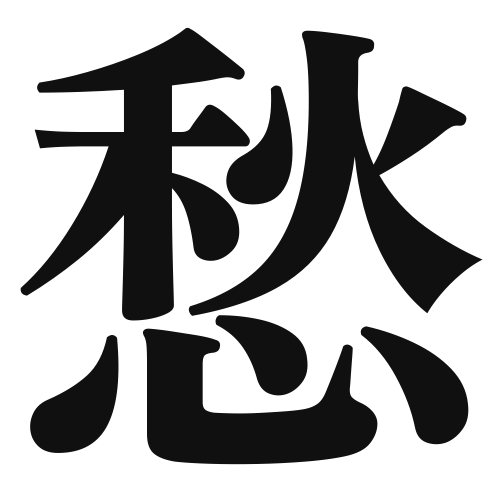1. Overview of Meaning
The kanji “愁” (shū) expresses feelings of sorrow, grief, or melancholy. It conveys a sense of deep emotional distress or worry, often related to loss or longing.
2. Formation and Radical
Formation of the Kanji: The kanji “愁” is a phonetic-ideographic character (形声文字). It combines the radical for “heart” (心) with a phonetic component that suggests its pronunciation and meaning related to emotions.
Radical: The radical of “愁” is 心 (shin), which relates to the heart and emotions, indicating that the kanji is associated with feelings.
3. Examples of Usage
Common Words and Phrases:
- 愁い (うれい, urei) – sorrow, grief
- 愁苦 (しゅうく, shūku) – anguish, distress
Example Sentences in Daily Conversation:
- 彼は失恋の愁いを抱えている。 (かれはしつれんのうれいをかかえている。) – He is carrying the sorrow of a broken heart.
- 愁苦の表情が彼女の顔に浮かんでいた。 (しゅうくのひょうじょうがかのじょのかおにうかんでいた。) – A look of anguish appeared on her face.
4. Synonyms and Antonyms
Similar Kanji:
- 悲 (ひ, hi) – sadness; while both express sorrow, “悲” is more general and can refer to sadness without the deeper emotional connotation of “愁”.
- 憂 (ゆう, yū) – worry; this kanji focuses more on anxiety rather than sorrow.
Antonyms:
- 喜 (き, ki) – joy; this kanji represents happiness and is the opposite of sorrow.
5. Cultural and Historical Background
Relation to Japanese Culture: The concept of “愁” is often reflected in traditional Japanese literature and poetry, where themes of longing and melancholy are prevalent.
Proverbs and Idioms:
- 「愁いを抱える」 (うれいをかかえる) – to carry sorrow; this phrase is used to describe someone who is burdened by grief.
